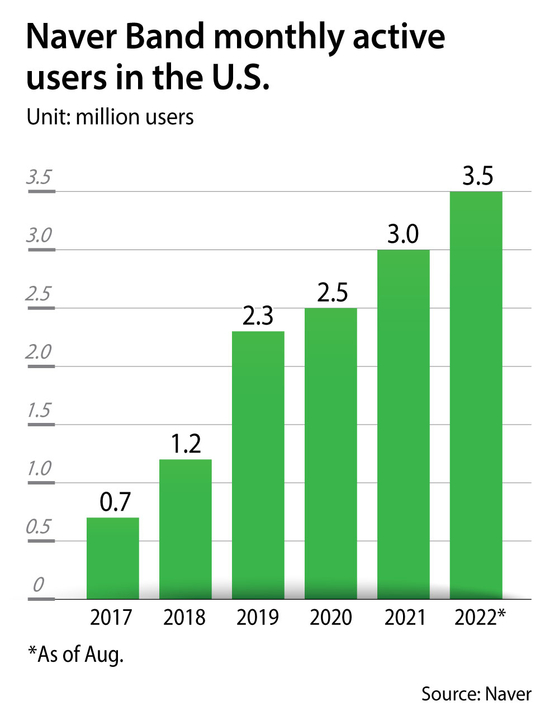Korean IT companies look to expand peoples' connections and their global presence
![Naver CEO Choi Soo-yeon speaks on April 13 during a press conference held at the Naver Green Factory headquarters building in Seongnam, Gyeonggi. [NAVER]](https://koreajoongangdaily.joins.com/data/photo/2022/11/15/fd526d90-85fb-4304-8d34-02eb569ee2bf.jpg)
Naver CEO Choi Soo-yeon speaks on April 13 during a press conference held at the Naver Green Factory headquarters building in Seongnam, Gyeonggi. [NAVER]
Two of the biggest buzzwords in the local big techs’ conference calls this year were “community” and “global.”
With the pandemic-driven growth spurt wearing off, Naver and Kakao — Korea’s leading internet companies — have been seeking breakthroughs in community-based services. The goal is to make users spend even more time on their apps hanging out with acquaintances or newfound online friends.
As the IT companies are actively pushing for market expansion beyond the Korean borders, community services became one of the key pillars of their global strategy, along with e-commerce and content.
“I believe that community lies at the center of Naver’s future growth engine,” said Naver CEO Choi Soo-yeon during the internet company’s third-quarter earnings conference call on Nov. 7.
Its traditional community platform service began with the Naver Cafe and Naver Blog services, which have been running for nearly 20 years. Its Naver Cafe forum service had 21 million weekly active users on average in 2021, compared to 18 million in 2019. Naver Blog also saw a 50-percent increase on year in its posting volume, with some 300 million posts published last year.
Naver Band, a social networking app, is expanding its presence both at home and abroad as well, especially in the United States.
First introduced in 2012, Naver Band has messenger and scheduler features.
In the U.S. market, the number of Naver Band’s monthly active users, which stood at 700,000 in 2017, reached 3.5 million as of August this year. Naver hopes to grow that number to 10 million in five years.

The major consumer base that drove Band’s growth in the country is after-school activity groups, such as sports, cheerleading and dance teams, according to Naver. The company explained that its localization strategy and feature updates reflecting the local consumers’ demand have set the Band app apart from its rivals in the U.S. market, like Facebook.
For example, Naver Band’s calendar function enables users to send out invitations and receive R.S.V.P. notifications.
“We have been upgrading the calendar feature in response to the U.S. consumers’ needs,” said a Naver spokesperson. “The calendar feature is only rarely used in Korea, where R.S.V.P. culture is not as common as it is in the United States, yet the U.S. users are giving positive feedback on its utility.”
To further expand its global community service line-up, Naver acquired Poshmark, a U.S. secondhand marketplace, at $1.6 billion in October. This is the biggest investment Naver has ever made in a single company.
Founded in 2011, Poshmark is the largest social marketplace in North America, with over 40 million active users.
“Naver is expanding the community service business share in its portfolio, and the recent acquisition [of Poshmark] is also part of the company’s strategy to further expand the community-based commerce business,” said Gu Sung-joong, DS Investment & Securities analyst. Whether the acquisition will translate into profits remains to be seen in the long term, according to Gu.
Meanwhile, Naver recently introduced interest-based community services for its sports live-streaming service, where users can share their thoughts while watching sports games online. The company hopes to expand the community services to other businesses related to content, finance, trending issues and more.
Kakao, the operator of the messenger app, is also considering interest-based community services as its next big thing.
In June, former Kakao co-CEO Namkoong Whon outlined the company’s metaverse vision named “Kakao Universe,” where users are connected to each other based on their interests.
“We believe that Kakao’s current services, which center around online communication between offline acquaintances, are not enough for global expansion,” said Namkoong during an online press conference on June 7, “That is why we are expanding the KakaoTalk service from acquaintance-based communication to interest-based community networking.”
Kakao has been preparing to introduce an “Open Link” app in the fourth quarter this year. Connected to the KakaoTalk messenger, the Open Link app will enable users to make an anonymous chatroom where people can create a community based on their interests and hobbies.
However, as Namkoong, who had been leading the projects, stepped down from his position following the massive Kakao service outage in October, the new project has been delayed by a month or two, according to Kakao.
The ultimate goal of the IT companies is to boost advertising revenue by increasing users’ app use duration.
“Both Naver and Kakao have been lacking a new growth driver after they introduced their Smart Channel and BizBoard ad services in 2019,” said Heo Ji-su, a Daishin Securities analyst, citing the companies' platform businesses. “Therefore they are coming up with new community services with the aim of increasing the ad impressions.”
An ad impression is the number of times an advertisement campaign is displayed.
Amid recession woes and the resulting decline in advertising revenue, Naver posted a net profit of 231.6 billion won ($174.1 million) for the third quarter, down 28.3 percent on year, while Kakao's net dropped 84.2 percent to 137.2 billion won.
BY SHIN HA-NEE [shin.hanee@joongang.co.kr]










with the Korea JoongAng Daily
To write comments, please log in to one of the accounts.
Standards Board Policy (0/250자)